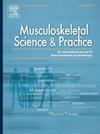与控制腰椎椎间盘造影术相比,方向偏好现象的同时有效性:一项诊断准确性研究的补充分析
IF 2.2
3区 医学
Q1 REHABILITATION
引用次数: 0
摘要
背景:持续性腰痛(LBP)是一种有许多潜在原因的症状。集中化现象(CP)已成为识别椎间盘源性疼痛子集的有前途的诊断工具。CP代表了表现出定向偏好(DP)的患者亚组,迄今为止,DP的诊断准确性从未被评估过。为了弥补这一差距,本研究评估了DP对椎间盘源性疼痛的诊断准确性,将其与CP的特性进行了比较,并探讨了DP检测阴性或无法进行重复运动测试的患者的临床诊断规则(cdr)的发展。方法对103例持续性腰痛患者进行物理治疗师评估,收集临床资料并确定DP状态。随后,放射科医生进行对照椎间盘造影术以确定椎间盘源性疼痛的状态。物理治疗师和放射科医生都不知道对方的发现。结果dp诊断准确率高(特异性0.94,阳性似然比(LR+): 7.65),筛查性低(敏感性0.48,阴性似然比(LR−):0.56)。CP表现出类似的诊断特性(特异性:0.94;LR+: 5.57)。不可测DP的CDR产生较低的预测能力(曲线下面积(AUC): 0.57)。由于样本量有限和数据缺失,当DP为阴性时,无法建立有效的CDR来辅助诊断决策。结论sdp是机械性椎间盘源性疼痛的有效诊断工具,但筛查作用有限。需要进一步的研究来完善诊断方法和探索亚组,例如那些有轻微变化/炎症驱动的椎间盘源性疼痛。本文章由计算机程序翻译,如有差异,请以英文原文为准。
Concurrent validity of the directional preference phenomenon compared to controlled lumbar discography: A supplementary analysis of a diagnostic accuracy study
Background
Persistent low back pain (LBP) is a symptom with many potential causes. Centralisation phenomenon (CP) has emerged as promising diagnostic tools for identifying a subset of discogenic pain. CP represents a subgroup of patients demonstrating Directional Preference (DP) and to date the diagnosticaccuracy of DP has never been assessed. To bridge this gap, this study evaluates the diagnostic accuracy of DP for discogenic pain, compares its properties to CP, and explores the development of clinical diagnostic rules (CDRs) for patients with negative testing for DP, or inability to undergo repeated movement testing.
Methods
103 persistent low back pain patients were assessed by a physiotherapist to collect clinical data and determine DP status. Subsequently, a radiologist performed controlled discography to determine the discogenic pain status. Both the physiotherapist and the radiologist were blinded to each other's findings.
Results
DP demonstrated high diagnostic accuracy (specificity: 0.94; Positive Likelihood Ratio (LR+): 7.65) but low screening properties (sensitivity: 0.48; Negative Likelihood Ratio (LR−): 0.56). CP showed similar diagnostic properties (specificity: 0.94; LR+: 5.57). A CDR for untestable DP yielded low predictive power (Area Under the Curve (AUC): 0.57). Due to limited sample size and missing data, no valid CDR could be established to assist diagnostic decision when DP is negative.
Conclusions
DP is a valid diagnostic tool for mechanical discogenic pain but has limited screening utility. Further studies are needed to refine diagnostic approaches and explore subgroups, such as those with Modic changes/inflammation-driven discogenic pain.
求助全文
通过发布文献求助,成功后即可免费获取论文全文。
去求助
来源期刊

Musculoskeletal Science and Practice
Health Professions-Physical Therapy, Sports Therapy and Rehabilitation
CiteScore
4.10
自引率
8.70%
发文量
152
审稿时长
48 days
期刊介绍:
Musculoskeletal Science & Practice, international journal of musculoskeletal physiotherapy, is a peer-reviewed international journal (previously Manual Therapy), publishing high quality original research, review and Masterclass articles that contribute to improving the clinical understanding of appropriate care processes for musculoskeletal disorders. The journal publishes articles that influence or add to the body of evidence on diagnostic and therapeutic processes, patient centered care, guidelines for musculoskeletal therapeutics and theoretical models that support developments in assessment, diagnosis, clinical reasoning and interventions.
 求助内容:
求助内容: 应助结果提醒方式:
应助结果提醒方式:


